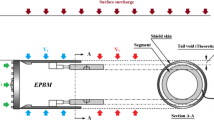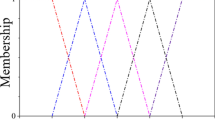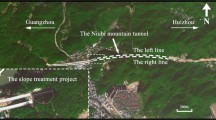Abstract
This study aims to predict ground surface settlement due to shallow tunneling and introduce the most affecting parameters on this phenomenon. Based on data collected from Shanghai LRT Line 2 project undertaken by TBM-EPB method, this research has considered the tunnel’s geometric, strength, and operational factors as the dependent variables. At first, multiple regression (MR) method was used to propose equations based on various parameters. The results indicated the dependency of surface settlement on many parameters so that the interactions among different parameters make it impossible to use MR method as it leads to equations of poor accuracy. As such, adaptive neuro-fuzzy inference system (ANFIS), was used to evaluate its capabilities in terms of predicting surface settlement. Among generated ANFIS models, the model with all input parameters considered produced the best prediction, so as its associated R 2 in the test phase was obtained to be 0.957. The equations and models in which operational factors were taken into consideration gave better prediction results indicating larger relative effect of such factors. For sensitivity analysis of ANFIS model, cosine amplitude method (CAM) was employed; among other dependent variables, fill factor of grouting (n) and grouting pressure (P) were identified as the most affecting parameters.
Similar content being viewed by others
References
ATTEWELL P B, YEATES J, SELBY A R. Soil movements induced by tunnelling and their effects on pipelines and structures [M]. London: Blackies and Sons, Ltd, 1986.
PALMSTROM A, STILLE H. Ground behaviour and rock engineering tools for underground excavations [J]. Tunnelling and Underground Space Technology, 2006, 22: 363–376.
NEAUPANE K M, ADHIKARI N. Prediction of tunneling-induced ground movement with the multi-layer perceptron [J]. Tunnelling and Underground Space Technology, 2006, 21(2): 151–159.
PECK R B. Deep excavation sand tunneling in soft ground [C]// Proceedings of the 7th International Conference on Soil Mechanics and Foundation Engineering. Mexico City, 1969: 225–290.
SUWANSAWAT S. Using artificial neural networks for predicting surface settlements over twin tunnels [C]// International Symposium on Underground Excavation and Tunnelling. Bangkok, Thailand, 2006: 309–318.
SHI J, ORTIGAO J, BAI J. Modular neural networks for predicting settlements during tunneling [J]. Journal of Geotechnical and Geoenvironmental Engineering, 1998, 124(5): 389–395.
KIM C Y, BAE G, HONG S, PARK C, MOON H, SHIN H. Neural network based prediction of ground surface settlements due to tunnelling [J]. Computers and Geotechnics, 2001, 28(6): 517–547.
SUWANSAWAT S, EINSTEIN H. Artificial neural networks for predicting the maximum surface settlement caused by EPB shield tunneling [J]. Tunnelling and Underground Space Technology, 2006, 21(2): 133–150.
BOUBOU R, EMERIAULT F, KASTNER R. Artificial neural network application for the prediction of ground surface movements induced by shield tunnelling [J]. Canadian Geotechnical Journal, 2010, 47(11): 1214–1233.
DARABI A, AHANGARI K, NOORZAD A, ARAB A. Subsidence estimation utilizing various approaches—A case study: Tehran No. 3 subway line [J]. Tunnelling and Underground Space Technology, 2012, 31: 117–127.
OCAK I, SEKER S E. Calculation of surface settlements caused by EPBM tunneling using artificial neural network, SVM, and Gaussian processes [J]. Environmental Earth Sciences, 2013, 70(3): 1263–1276.
AHANGARI K, MOEINOSSADAT S R, BEHNIA D. Estimation of tunnelling-induced settlement by modern intelligent methods [J]. Soils and Foundations, 2015, 55: 737–748.
HOU J, ZHANG M, TU M. Prediction of surface settlements induced by shield tunneling: An ANFIS model [M]. London: Taylor & Francis Group, 2009: 551–554.
QIAO J, LIU J, GUO W, ZHANG Y. Artificial neural network to predict the surface maximum settlement by shield tunneling [C]// ICIRA’10 Proceedings of the Third International Conference on Intelligent Robotics and Applications. 2010: 257–265.
JONG Y H, LEE C I. Influence of geological conditions on the powder factor for tunnel blasting [J]. International Journal of Rock Mechanics and Mining Sciences, 2004, 41(1): 533–538.
WHITTAKER B, REDDISH D. Subsidence: Occurrence, prediction and control (Developments in geotechnical engineering, 56) [M]. Amsterdam: Elsevier, 1989.
KHANDELWAL M, SINGH TN. Prediction of blast induced ground vibrations and frequency in opencast mine: a neural network approach [J]. Journal of Sound and Vibration, 2006, 289(4): 711–725.
HAGHNEJAD A, AHANGARI K, NOORZAD A. Investigation on various relations between uniaxial compressive strength, elasticity and deformation modulus of asmari formation in Iran [J]. Arabian Journal for Science and Engineering, 2014, 39: 2677–2682.
BEHNIA D, AHANGARI K, NOORZAD A, MOEINOSSADAT S R. Predicting crest settlement in concrete face rockfill dams using adaptive neuro-fuzzy inference system and gene expression programming intelligent methods [J]. Journal of Zhejiang University: Science A (Applied Physics & Engineering), 2013, 14(8): 589–602.
GARG A, TAI K, VIJAYARAGHAVAN V, SINGRU P M. Mathematical modelling of burr height of the drilling process using a statistical-based multi-gene genetic programming approach [J]. The International Journal of Advanced Manufacturing Technology, 2014, 73: 113–126.
JANG J S R. ANFIS: Adaptive-network-based fuzzy inference systems [J]. IEEE Transactions on Systems, Man, and Cybernetics, 1993, 23(3): 665–685.
KARTALOPOULOS S V. Understanding neural networks and fuzzy logic [M]// Basic Concepts and Applications. IEEE Press, 1996.
JANG J S R, SUN C T. Neuro-fuzzy modeling and control [J]. Proceedings IEEE, 1997, 83(3): 378–406.
JANG J S R, SUN C T, MIZUTANI E. Neuro-fuzzy and soft computing a computational approach to learning and machine intelligence [M]. New Jersey: Prentice Hall, 1997.
BEHNIA D, MOEINOSSADAT S R, BEHNIA B, BEHNIA M, SAFARI-GORGI A, ZAKERIAN P. Prediction of settlement in sloping core rockfill dams using soft-computing [J]. Research in Civil and Environmental Engineering (RCEE), 2014, 2(2): 55–65.
JALALIFAR H, MOJEDIFAR S, SAHEBI A A, NEZAMABADIPOUR H. Application of the adaptive neuro-fuzzy inference system for prediction of a rock engineering classification system [J]. Computers and Geotechnics, 2011, 38: 783–790.
BEZDEK J. Fuzzy mathematics in pattern classification [D]. Ithaca: Cornell University, 1973.
ROSE T J. Fuzzy logic with engineering applications [M]. 3rd ed. New Mexico: John Wiley & Sons, Ltd, 2010.
Author information
Authors and Affiliations
Corresponding author
Rights and permissions
About this article
Cite this article
Moeinossadat, S.R., Ahangari, K. & Shahriar, K. Calculation of maximum surface settlement induced by EPB shield tunnelling and introducing most effective parameter. J. Cent. South Univ. 23, 3273–3283 (2016). https://doi.org/10.1007/s11771-016-3393-5
Received:
Accepted:
Published:
Issue Date:
DOI: https://doi.org/10.1007/s11771-016-3393-5




